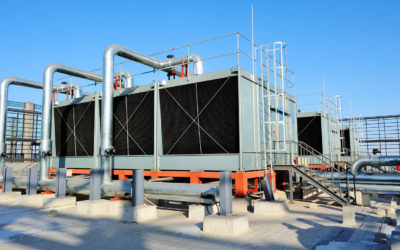As facilities prepare to startup cooling systems in the Spring, they are also shutting down boiler systems for storage during the summer months. Proper preparation is key to protecting these assets while shut down and also ensuring they are in top condition and ready for startup in the fall.
Boilers are stored “dry” or “wet.” The dry method of storage is recommended for periods of one month or longer. When the lay-up will be for shorter periods or where rapid return to service may be necessary, the conventional wet method of storage is preferable.
THE DRY METHOD
After the boiler has been drained and flushed, it should be thoroughly dried. This can be done by air circulation or by a very light fire in the furnace.
Desiccants traditionally used in this application are quick lime or commercial silica gel. When the boiler is completely dry, place the quick lime or commercial silica gel in suitable trays along the length of the steam and mud drums. These trays should be supported by blocks of wood in such a manner as to permit free circulation of air underneath. Seal all openings completely.
The amounts of hydrate required for effective moisture control are 8 lbs. of lime or 4 lbs. of silica gel per 1,000 lbs. per hour of boiler steam capacity. The boiler should be inspected at two to three month intervals and if the hydrating material is found to be damp, it should be replaced. After each inspection the boiler should immediately be re-sealed.
Recently, new, easier to use technology has become available for this application. Vapor phase corrosion inhibitors are placed inside a dried boiler, opened, and then the boiler is sealed. These products protect metals by providing a corrosion inhibitor in the vapor phase inside of the boiler or vessel being protected. These have become the preferred method over the older desiccant products traditionally used.
THE WET METHOD
Preparations for wet storage need to begin about a week before the actual shutdown. The boiler blowdown should be increased to drop conductivity by about 25% of the typical operating control target. Also, chemistry levels should be increased in preparation for shutdown, taking these levels to near or at the top of the typical control ranges.
As shutdown arrives, typically this is a good time to inspect the boiler internals for any maintenance work that needs to be completed. Once this is complete, the boiler will need to be refilled. The water temperature should be raised to approximately 200oF, leaving the top drum vents open so any air present will be driven off. With sufficient firing to keep the water circulating, add a sufficient amount of a sodium sulfite-containing product to develop a residual sulfite of 200 ppm, or add a DEHA product to develop a minimum 100 ppm DEHA concentration. In addition, add sufficient caustic soda or alkalinity builder to increase the ‘P’ alkalinity to 1000 ppm.
As the water cools, an air space will develop at the top of the boiler. The water level must be checked daily and the boiler kept completely full, ideally recirculating the water periodically. A sample should be taken once a week and tested for proper chemical content.
THE NITROGEN BLANKETING METHOD
This method is used in boilers where immediate return to service may be required. This method is a modification of the wet storage method in that the water in the boiler is maintained at the normal operating level and this water is treated as recommended under the wet method. In addition, nitrogen is pressurized into the unit when it is sealed to prevent oxygen intrusion.
RETURNING THE BOILER TO SERVICE FOLLOWING STORAGE
Starting up after dry storage requires the same procedures as when starting up a new boiler or one that has just been cleaned and/or inspected and is being returned to service.
For a boiler stored under the conventional wet storage method, it will be necessary to drain it to the normal operating level prior to firing. The water level controls should be checked to assure they are still functioning. Then, the boiler can be fired in the usual manner. During the first day or so, it should be blown down heavily until chemical balances in the boiler water are brought into normal control ranges.
For a nitrogen blanketed unit, it is only necessary to turn off the nitrogen and close the valve through which the nitrogen has been added, open the valve to the steam header and fire the boiler. Again, blowdown should be heavy for the first day or so of operation until normal boiler water treatment control levels are re-established.
NEED MORE INFORMATION?
For more information about boiler best practices or any other water treatment formulation needs, fill out the form below to get in touch with a QualiChem Water Treatment Expert.



